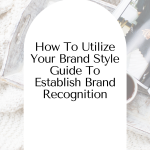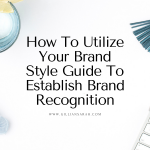
How To Utilise Your Brand Style Guide To Establish Brand Recognition
Table of Contents
ToggleSharing is caring!
Reading Time: 4 minutes


What is a brand style guide, and why is it an essential part of establishing a memorable brand? If you’ve no clue how to create your brand style guide, try these tips.
Ever wonder what's a brand style guide and why it's so important in branding? A brand style guide is a document that presents the visual elements of a brand. The guide helps content creators like yourself craft a consistent message to their target audience. Essentially, a brand style guide conveys your brand's design standards to clients to establish a trusted and recognizable brand.
Brand Style Guide by Elements
Every brand has different visual styles, and you have to figure out your own unique visual style to build a memorable brand. The sooner you figure out your branding style, the better it will be for your marketing campaign. Ultimately, the goal is to get people to remember your business through these design elements:
Main Logo
Your main logo represents your brand, and it will appear across all your business' platforms and marketing materials. You can create the logo yourself or hire a professional to create one for you. As for the type of logo to use, you can opt for:
Wordmark: An all-text logo
Lettermark: Use text initials instead of an entire name
Icons and Symbols: Imageries as the logo with or without texts
Submarks or Alternate Logos
Your alternate logos are the different variations of your main logo. To keep the branding consistent, your alternate logo should look similar to the main logo. It may share the same colour, layout, or typography, so people will know that the alternate logo is a part of your brand.
You'll use these logos in situations when you cannot use your main logos. For example, if the spacing is too small for a large logo, you can use your alternate logo. Or if the main logo doesn't fit a certain look or theme, use an alternate logo.
Colour Palette
Your colour palette represents your brand colours. As you know, colours play an important part in establishing an emotional connection with a brand. If you want to attract future clients to your business, you need to elicit the right emotions. This means each colour in your colour scheme should evoke a specific emotion with your target audience.
You can choose up to 6 colours for your colour palette. Also, choose a complementing mix of light and dark colours for your brand style guide.
Typography
Typography consists of font styles for your brand's main headings, sub-headings, and body font. These font styles are implemented on your website and marketing materials. You can play with different font styles to create an attractive combination but nothing too distracting that it puts people off. The key is to use 3 core font styles.
Hero Font: Used for main headings
Support Font: Used for subheadings and emphasis
Body Font: Used for large bodies of texts
You’ll use your core font styles in all branding elements and marketing materials, including printed ads, signages, online graphics, and so on. The styles should be consistent across all platforms so that people will come to associate these fonts with your business.
Textures and Patterns
Certain textures and patterns could be used to represent your brand or correlate with your branding elements. When combined with your colour scheme, logos, and fonts, textures, and patterns create a visual display that’s distinct to your brand.
Patterns: These are brand elements used to reinforce certain moods or themes that are in line with the business. Patterns are often tileable to cover any area.
Textures: Textures add richness to the branding elements for a pleasing sensory experience. The textures could be used as backgrounds for texts or campaigns. The textures, just like any of your branding elements, should be consistent across all platforms and materials.
Mood Board
What’s a mood board, and why do you need one? A mood board consists of imagery that represents the look and feel of a brand. It’s often used by designers to determine what look a client is going for.
A mood board is similar to a Pinterest board; you’re filling a space with images that represent the kind of brand that you’d like to build. When creating your own mood board, look for images that represent the moods or tones that you want your brand to express. The look and feel of the images should attract your ideal clients visually and a taste of what’s to come.
Signature
A signature is perhaps one of the most overlooked branding elements there is. It’s not something that all brands have, but it’s nice to have if you want to give your emails, newsletters, or blog posts extra flair. A customized signature also adds a personal touch to your email and website content. You can also use a signature anywhere you’d like to sign your name on.
Favicons
Yet another often-overlooked branding elements are favicons, mostly because of their size. Favicons are the teeny-tiny icons or images that are displayed in the web browsers’ address bar. These are about 64 x 64 pixels in size and most times, consist of a small submark, tiny image, a letter, or an icon. Well-chosen favicons add a nice touch to your visual branding.
Creating a Brand Style Guide is a must when you want to create a cohesive and polished visual identity. It’s key to creating a successful, not to mention, memorable brand. So go ahead, put together your own brand style guide as soon as possible to define your business.
Most Popular Posts:
Sharing is caring!
PLEASE COMMENT BELOW